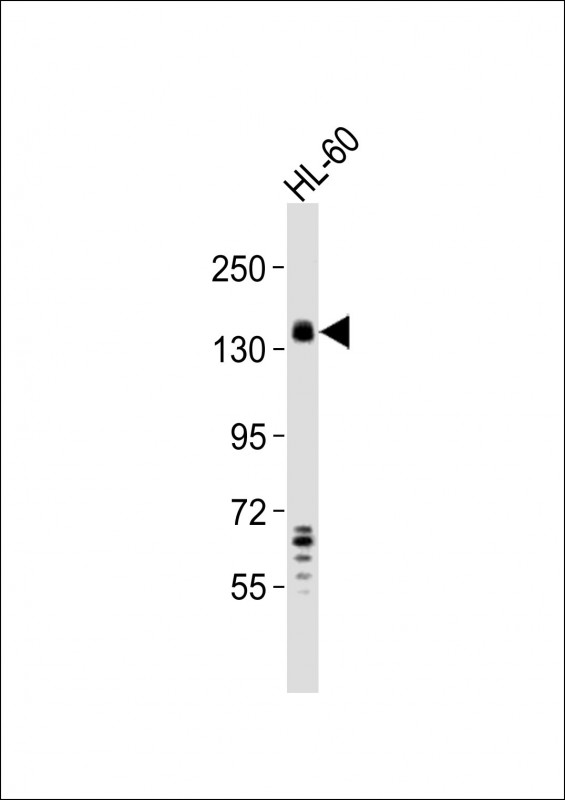SEMA4D Antibody (Center)
Purified Rabbit Polyclonal Antibody (Pab)
- SPECIFICATION
- CITATIONS
- PROTOCOLS
- BACKGROUND

Application
| WB, E |
|---|---|
| Primary Accession | Q92854 |
| Reactivity | Human |
| Host | Rabbit |
| Clonality | polyclonal |
| Isotype | Rabbit IgG |
| Calculated MW | 96150 Da |
| Gene ID | 10507 |
|---|---|
| Other Names | Semaphorin-4D, A8, BB18, GR3, CD100, SEMA4D, C9orf164, CD100, SEMAJ |
| Target/Specificity | This SEMA4D antibody is generated from a rabbit immunized with a KLH conjugated synthetic peptide between 553-587 amino acids from the Central region of human SEMA4D. |
| Dilution | WB~~1:2000 E~~Use at an assay dependent concentration. |
| Format | Purified polyclonal antibody supplied in PBS with 0.09% (W/V) sodium azide. This antibody is purified through a protein A column, followed by peptide affinity purification. |
| Storage | Maintain refrigerated at 2-8°C for up to 2 weeks. For long term storage store at -20°C in small aliquots to prevent freeze-thaw cycles. |
| Precautions | SEMA4D Antibody (Center) is for research use only and not for use in diagnostic or therapeutic procedures. |
| Name | SEMA4D |
|---|---|
| Synonyms | C9orf164, CD100, SEMAJ |
| Function | Cell surface receptor for PLXNB1 and PLXNB2 that plays an important role in cell-cell signaling (PubMed:20877282). Regulates GABAergic synapse development (By similarity). Promotes the development of inhibitory synapses in a PLXNB1-dependent manner (By similarity). Modulates the complexity and arborization of developing neurites in hippocampal neurons by activating PLXNB1 and interaction with PLXNB1 mediates activation of RHOA (PubMed:19788569). Promotes the migration of cerebellar granule cells (PubMed:16055703). Plays a role in the immune system; induces B-cells to aggregate and improves their viability (in vitro) (PubMed:8876214). Induces endothelial cell migration through the activation of PTK2B/PYK2, SRC, and the phosphatidylinositol 3-kinase-AKT pathway (PubMed:16055703). |
| Cellular Location | Cell membrane; Single-pass type I membrane protein |
| Tissue Location | Strongly expressed in skeletal muscle, peripheral blood lymphocytes, spleen, and thymus and also expressed at lower levels in testes, brain, kidney, small intestine, prostate, heart, placenta, lung and pancreas, but not in colon and liver |

Thousands of laboratories across the world have published research that depended on the performance of antibodies from Abcepta to advance their research. Check out links to articles that cite our products in major peer-reviewed journals, organized by research category.
info@abcepta.com, and receive a free "I Love Antibodies" mug.
Provided below are standard protocols that you may find useful for product applications.
Background
Cell surface receptor for PLXN1B and PLXNB2 that plays an important role in cell-cell signaling. Promotes reorganization of the actin cytoskeleton and plays a role in axonal growth cone guidance in the developing central nervous system. Regulates dendrite and axon branching and morphogenesis. Promotes the migration of cerebellar granule cells and of endothelial cells. Plays a role in the immune system; induces B-cells to aggregate and improves their viability (in vitro). Promotes signaling via SRC and PTK2B/PYK2, which then mediates activation of phosphatidylinositol 3-kinase and of the AKT1 signaling cascade. Interaction with PLXNB1 mediates activation of RHOA.
References
Hall K.T.,et al.Proc. Natl. Acad. Sci. U.S.A. 93:11780-11785(1996).
Humphray S.J.,et al.Nature 429:369-374(2004).
Ota T.,et al.Nat. Genet. 36:40-45(2004).
Tamagnone L.,et al.Cell 99:71-80(1999).
Basile J.R.,et al.Mol. Cell. Biol. 25:6889-6898(2005).
If you have used an Abcepta product and would like to share how it has performed, please click on the "Submit Review" button and provide the requested information. Our staff will examine and post your review and contact you if needed.
If you have any additional inquiries please email technical services at tech@abcepta.com.













 Foundational characteristics of cancer include proliferation, angiogenesis, migration, evasion of apoptosis, and cellular immortality. Find key markers for these cellular processes and antibodies to detect them.
Foundational characteristics of cancer include proliferation, angiogenesis, migration, evasion of apoptosis, and cellular immortality. Find key markers for these cellular processes and antibodies to detect them. The SUMOplot™ Analysis Program predicts and scores sumoylation sites in your protein. SUMOylation is a post-translational modification involved in various cellular processes, such as nuclear-cytosolic transport, transcriptional regulation, apoptosis, protein stability, response to stress, and progression through the cell cycle.
The SUMOplot™ Analysis Program predicts and scores sumoylation sites in your protein. SUMOylation is a post-translational modification involved in various cellular processes, such as nuclear-cytosolic transport, transcriptional regulation, apoptosis, protein stability, response to stress, and progression through the cell cycle. The Autophagy Receptor Motif Plotter predicts and scores autophagy receptor binding sites in your protein. Identifying proteins connected to this pathway is critical to understanding the role of autophagy in physiological as well as pathological processes such as development, differentiation, neurodegenerative diseases, stress, infection, and cancer.
The Autophagy Receptor Motif Plotter predicts and scores autophagy receptor binding sites in your protein. Identifying proteins connected to this pathway is critical to understanding the role of autophagy in physiological as well as pathological processes such as development, differentiation, neurodegenerative diseases, stress, infection, and cancer.


